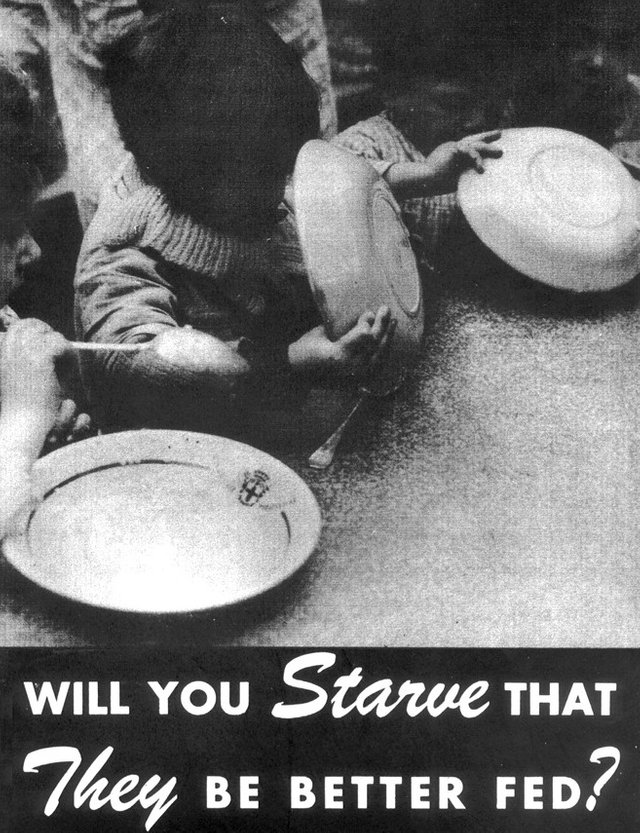The Minnesota Starvation Experiment

'Will you starve that they be better fed?' This was on the cover of the recruitment brochure for the Minnesota Experiment on May 27, 1944.
Later that year, in November, Ancel Keys and his team of scientists recruited 36 normal healthy male participants (20 - 33 years old) that would undergo a 1-year experiment. Researchers wanted to mimic the lives of people affected by war. Ancel Keys' motivation was to find strategies that would help the victims of famine.
The study along with other relevant experiments made the subject of two large books of 1,400 pages - [1]. In this post I'm going to try and boil it all down to a few hundred words...
The Minnesota Study
The experiment was broken down into phases [2]:
Phase 1: control diet for 3 months
- daily caloric intake: ~3,200 kcals
- exercise: walking ~20 miles/week
- purpose of the phase: 25% bodyweight loss
Phase 2: semi-starvation diet: between February and July 1945
- daily caloric intake: ~1,570 kcals
- foods consumed similar to those of war victims: potatoes, sugar, bread, cabbage, jam, jello, oatmeal, and macaroni, with little meat and dairy products [3].
"On d 1 of semistarvation, February 12, 1945, the men sat down to a meal that included a small bowl of farina, two slices of toast, a dish of fried potatoes, a dish of jello, a small portion of jam, and a small glass of milk." [2]
- some subjects dropped to 99 pounds, losing 50 pounds of their initial weight:
"Striking changes occurred in the size and weight of the subjects, the average loss of gross body weight at the end of semistarvation representing twenty four per cent of the control value. Both the face and the body showed a marked emaciation. Gradual wasting of muscle and subcutaneous adipose tissues made sitting on hard surfaces increasingly uncomfortable and sometimes painful." [4]
Phase 3: controlled rehabilitation: between July and October 1945
- daily caloric intake: 2,200 to 4,000 kcals
- some groups of subjects consumed closer to 2,200 kcals, while other groups closer to 4,000 kcals
Phase 4: uncontrolled rehabilitation: post Oct. 1945
- daily caloric intake: ad libitum (as much as they wanted)
- the average was 5,200 kcals/day, but some subjects ate as much as 10,000 kcals/day
- what's interesting to point out [2]:
"Although they were warned to be careful not to overeat on d 1, they were free to eat as they wished. Henry Scholberg remembered being taken to the hospital to have his stomach pumped because he “just simply overdid.” Harold Blickenstaff was sick on the bus on the way back from one of the several meals he had d 1; he found that he simply “… couldn’t satisfy [his] craving for food by filling up [his] stomach."
Notes

According to Keys and colleagues, the most dramatic changes in the subjects took place in the semi-starvation phase. From one of my previous posts:
"As weight went off, their physical aspect degraded. With lower core body temperature, a poor diet, and poor heart rate variability, they lost their sex drive and stamina, and became disengaged and disinterested in many aspects of their lives."
I personally think that a 1,600 kcals diet cannot be called starvation if appropriate foods are selected. There are many health people who are successfully under consistent caloric restriction for years; they optimize their diets for nutrient density instead of energy density: consuming foods high in vitamins, minerals, and micronutrients.
Similarly, there are people who fast for weeks to months (consume nothing but water) and never experience the dramatic changes seen in these subjects. However, the physiology of water fasting is much different compared to that of calorie restriction (of any kind).
The quality of the diet in the semi-starvation phase was poor as it was mostly focus on low-nutrient-dense highly-processed carbohydrate rich foods. It is understandable though: the purpose was to mimic the diets of the victims of famine.
Here's how Keys and colleagues picture the situation in the study from 1948 [4]:
“Fatigue, weakness, and hunger were outstanding complaints. The marked reduction in strength and endurance was paralleled by a curtailment of spontaneous activity. The subjects moved slowly and cautiously; they climbed stairs one at a time. Coordination was affected and the men sometimes tripped over curbstones and bumped into objects which they intended to sidestep.”
Subjects developed food triggered psychologic disorders:
- excessive gum chewing (up to 40 packs/day)
- excessive coffee and tea consumption (up to 15 cups of coffee/day)
- excessive water consumption
- excessive smoking
- obsessive behavior regarding food/eating [2]:
"Robert Willoughby remembered the often complex processes the men developed for eating the little food that was provided: “… eating became a ritual … Some people diluted their food with water to make it seem like more. Others would put each little bite and hold it in their mouth a long time to savor it. So eating took a long time.” Carlyle Frederick was one of several men who collected cookbooks and recipes; he reported owning nearly 100 by the time the experiment was over."
I suspect that their diets along with the extremity of these habits lead to a very poor physiologic state. Increased insulin secretion in a low caloric context could have been the potential cause for their reporting of excessive and non-stop hunger.
The last important point to know is that it took long-term over-consumption of calories until the participants returned their weight to baseline and until their food driven psychopathologies have faded away [2]:
"Many also reported eating excessively after they left Minnesota; Jasper Garner described it as a “year-long cavity” that needed to be filled. Many, like Roscoe Hinkle, put on substantial weight: “Boy did I add weight. Well, that was flab. You don’t have muscle yet. And get[ting] the muscle back again, boy that’s no fun.” Estimates for how long it took to fully recover ranged from 2 mo to 2 y, but none of the men believed there were any negative long-term health effects from participation."
Ending Thoughts
If you want to see pictures of the subjects, look at study [2] linked above or do an image search of 'minnesota starvation'. If you want to know the fine details of this experiment, I'd recommend reading studies [2] and [4] referenced above. But of course, you can also read the entire 1,400 pages [1] if you want to know everything about the Minnesota Experiment.
In my opinion, the motivation behind this experiment as well as the willingness of the participants to push through deserve my deepest admiration. There is no point in criticizing the composition of diet when the bigger picture (the cause) falls into perspective.
To stay in touch with me, follow @cristi
Credits for Images: [Adapted from Journal of Nutrition] and [The Minnesota Starvation Experiment].
#research #physiology #biochemistry
Cristi Vlad, Self-Experimenter and Author
Hi @cristi,
You have been chosen as a featured author by the @robinhoodwhale initiative.
Learn more about the Robinhood Whale here!
Keep on Steeming more amazing posts!
Goodluck!
~RHW~
thank you!
Great post
thanks Rep!
Fascinating
Very interesting, following you for more posts like this one.
Thank you
and there will be :) I also follow you.
Thank you so much. You have high quality posts!
Nutrient density to eat the required amount of vitamins and minerals, is more important than eating calories, as you suggest, although both matter. I wonder how would we survive and be fit if all we ate were nutrient supplemental tablets? I don't think it is enough, as energy is a requirement for input/output in a body. Maybe if we were in a robot society where we did no physical labor at all LOL. Energy is important to get around and do things, do maintain muscle, etc.
Take care. Peace.
you can survive with no food for months, provided you drink water and you have sufficient fat on your body. and it's not like you're stuck to bed, but you can live a fairly active life like that. very few people do it nowadays. we are consumers...
I'd rather fast than consume products like 'soylent' or other 'total-meal-replacements'. it feels more 'natural' not to eat anything for a certain period of time than eating something that doesnt feel or taste like food. 'soylent' and other products remove the pleasure we get from eating. fasting makes you forget about it...anyways, thanks for your feedback
It is interesting to notice that most of these guys have replaced food by something else (coffee, cigarets, etc.), and when the experience was over they try to catch up on 2 days...
hey @lemouth, I'm not sure what you mean by 'catch up on 2 days...' :) can you elaborate please?
I was referring to the over-eating phase.
Oh wow! I know these experiments were done in the name of science, but I find them disturbing anyway.
and you think they were eating 1600 kcals, which is far from what I consider starvation, but nevertheless...their diets were low nutrient
amazing post @cristi
thank you! :)
This was a very interesting read. I live in Minnesota, and like learning about the various things in history that took place here. Thanks for sharing! Upvoted and following!
Very interesting. I was born in Minnesota and lived there for 15 years. Never knew about this. At least this was an experiment they knowingly participated in. Blessings to their selflessness.